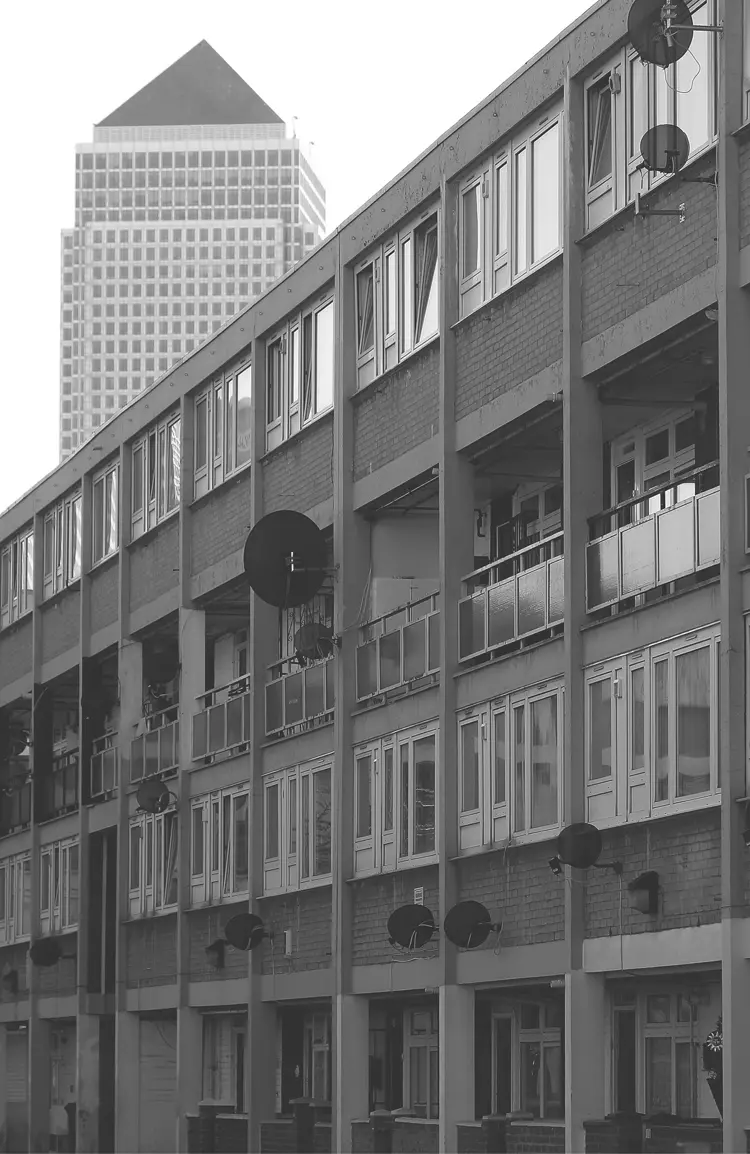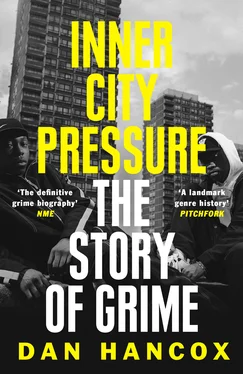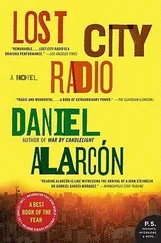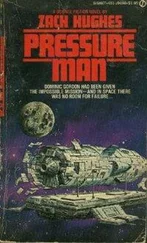Crimewatch – gone to jail for armed robbery, come out, become a major UK garage MC and a major drug dealer (at the same time), had hits and gone back on primetime TV, but as a pop star. There’s Lady Fury, unmoved by being – as she often was – the only woman in a room full of jostling male egos, getting plaudits for her ferocity: ‘I don’t give head, but I give headbutts,’ she spits, and the record playing underneath, ‘Ho’ by Dizzee Rascal, is wheeled back as her male peers throw their hands up. ‘Dun no I represent for the ladies,’ she says, as the stuttering gunshots of the instrumental start up again. There’s Tinchy Stryder, still in school, expounding the strange wisdom of youth, ‘brand new energy, same old Stryder,’ he spits, like he’s been doing this for years – he has – clutching the microphone with both hands like his life depends on it. And then there’s Wiley, the godfather of grime, whose manic enthusiasm and hilarious non-sequiturs suddenly give way to moments of sublime clarity, like when he captures the whole bizarre and uniquely skittish practice of grime MCing: ‘I’m futuristic, quantum leaping/there’s no defeating E3 tiger/see me creep on the riddim like a spider/kill them with a 16-liner.’ Grime ‘spitting’ is twice the speed of US-style rap: typically, you had just 16 bars to show your skills (or 21 seconds, in So Solid Crew’s case), before passing the mic to the next MC – it is the most thrilling, exhausting, ADHD onslaught of a genre: a tension headache you can dance to. Andy Warhol’s generation should count themselves lucky they got fifteen entire minutes to make an impact. But for all the idiosyncratic talents, they’re in it together. The powerful conviviality and kinship in a genre where lyrical threats of violence are one of the primary means of communication may be surprising, but it’s there all the same – a chain created between artists every time the mic is passed from one MC to the next.
As the energy of the set mounts, Crazy Titch is bopping with cartoonish energy, his face screwed up at the sheer meanness of the track playing underneath, his blitzkrieg of bars including the lyric, ‘Draw for me, you’ll be on the Ten O’Clock News.’ Only three years later, he actually was on the Ten O’Clock News , when he was charged with murder: a moment when grime’s casual lyrical brutality was horribly borne out in reality. ‘When Titch came in, I could feel there was an edge,’ Troy Miller says. ‘He changed the dynamics of the room. Everything got a bit more serious, whereas it was all fun and banter before.’
Throughout the Conflict video Dizzee’s voice has that lean, straining, high-pitched teenager’s tone, altogether gone from his songs now that his throat’s been fleshed out by success, and time. He is visibly defensive, an outsider even among his peers, the boy in the corner of the room, just as he was at school. Titch is much less guarded, happily lost in the music, grinning when he passes the mic to Dizzee, nodding his head to his rival’s bars, adding a cheerful ‘what!’ to Dizzee’s lyrics in choral emphasis.
There’s no sense of a fight in the offing for the first, enthralling 35 minutes of the video – it explodes from absolutely nowhere. Dizzee asks for the mic, is refused by Titch, who is still in full flow, and somehow in a split second the two of them are yelling at each other and squaring up, fingers are pointed, and the music underneath cuts out abruptly, like in a spaghetti western; the card tables are flipped over, the piano stops playing and the saloon doors are left swinging in the breeze.
Wiley and Maxwell D are immediately in between the two young MCs – the elder statesmen who’ve seen this kind of bullshit before, and seen it get out of hand before. Wiley takes charge, the man who has always behaved like he cares more for the scene’s collective success than his own. (‘What’s the highlight of your career so far?’ Wiley was asked in 2017. ‘Skepta making it.’ ‘No, your highlight,’ the interviewer pressed. Wiley wouldn’t change track: ‘Skepta. I took him from a DJ to an MC.’ 1) He holds them back, instructing them to ‘seckle, seckle’, his eyes darting all around the room as other MCs move in to either help or hinder the rapprochement. Dizzee and Titch are pulled apart still shouting at each other, and everyone spills out onto the rooftop from the TARDIS-like studio, silhouetted against the dark blue east London gloaming, as friends attempt to calm them down.
‘Don’t hold him back, don’t hold him back,’ Dizzee yelps, as the struggle to defuse the anger continues. He was still so young at this point – still barking his anger out, straining passionately, defensively, hungry both on the mic and in the fight with Titch. ‘I’M NOT A MOOK, I don’t know what they told you but I’m not a mook!’ he yells repeatedly at an equally aggressive Titch. He’s scowling, livid – determined to defend his reputation. No one seems to agree on the etymology of ‘mook’ here (it might be a throwback to Scorsese’s Mean Streets ), but it’s clear from the rage in Dizzee’s eyes, and in his voice, that he’s not one, right?
The clash looks serious, and is taken seriously by all the others present on the rooftop – and it was soon followed up by diss tracks from each MC to the other. As menacing as they both look when they’re screaming at each other, the scrap is underscored by grime’s quintessential, frequently comic tendency to the melodramatic. When the scuffle starts, it could almost be a scene from EastEnders – appropriately, given the location. When the music cuts out abruptly, amid the clamour of raised voices and bravado we hear ‘step outside!’, ‘leave it, man’.
Three years later, Carl ‘Crazy Titch’ Dobson was sentenced to life imprisonment for his involvement in the murder of 21-year-old Richard Holmes, a crime that supposedly originated in a disrespectful grime lyric. In that Deja Vu show, Crazy Titch is captivating, going a hundred miles an hour on the mic, arms pumping, grinning ear to ear, wiping the sweat from his brow with his T-shirt. It’s not a stretch to suppose that the gleeful, reckless energy he displays on the mic came from the same place as his manic, unhinged tendencies.
There’s no blue plaque on the building commemorating this pivotal evening in the history of British music, because there is no building left at all. In 2003 Deja Vu was on the edge of an industrial estate, in a scrappy, marshy part of Stratford that was about to be wiped off the map – grime’s machine gun snares and adolescent yelps were among the final, spluttering cries of the informal city. The pirate studio only lasted a few months there before moving on again, and the block that housed it was soon bulldozed to make way for the mannered and manicured London 2012 site, and the £486-million Olympic stadium.
Dizzee was back in the same spot that summer, nine years after his fight with Crazy Titch, to perform his number-one hit ‘Bonkers’ at the £27m London 2012 opening ceremony, to an estimated global TV audience of 900 million people. He wore a specially embroidered E3 baseball jacket, honouring the east London postcode that will forever be synonymous with grime.
‘Forget all this, man, forget all this,’ one MC is heard saying after the fight breaks out, attempting to subdue the rising temperature. He meant they should forget the beef – and soon enough, they did. But as this hyper-local rhythm began to reverberate beyond the narrow radius of the pirate transmitters, a great deal more was forgotten with it.

Canary Wharf and Limehouse, 2002
Читать дальше













